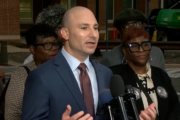The celebrated singer Mariah Carey recently introduced fans to something that — for many — was new, and it wasn’t a song debut. Rather, she opened up about her struggles with what’s called bipolar II disorder.
While depression is more common, most people would probably be familiar — at least to a limited degree — with bipolar disorder, or more precisely, what’s referred to as bipolar I.
“Bipolar I disorder is what used to be called classic manic depressive illness,” says Dr. Anthony Rothschild, a professor of psychiatry at the University of Massachusetts Medical School. Those who have it experience periods of mania — that is, “of increased energy, not needing to sleep, talking fast, having what’s called flight of ideas — where they jump from one topic to another,” he says. “They usually are in a very euphoric mood, although occasionally it can be an irritable mood.” During this high-energy, high-activity period, people can sometimes even be delusional. “They can think they’re Jesus Christ or they have to talk to the Pope or the president immediately. That kind of manic episode almost always leads to hospitalization,” Rothschild says.
But though the mania jumps out, those with bipolar more frequently experience low mood. “They have periods of time when they suffer from depression,” Rothschild says. “They can’t think straight, they’re sad, they have no motivation, they can be feeling suicidal.”
[See: 9 Things to Do or Say When a Loved One Talks About Taking Their Life.]
With bipolar I, people have periods of depression, mania and normal mood in between. And that same episodic nature defines bipolar II, as well. But instead of mania, individuals with bipolar II experience what’s called hypomania. “The two kinds of differences between mania and a hypomanic episode are duration and severity,” says Dr. Keming Gao, a professor of psychiatry and co-director of the Bipolar Disorder Research Center at Case Western Reserve University School of Medicine in Cleveland. “So for mania it must last more than seven days, and in terms of severity it must cause significant impairment consequences.” Mania causes dysfunction that can lead to serious consequences, such as interpersonal or professional problems at home or work, and engaging in risky behavior, like reckless driving. By contrast the symptoms of hypomania are less severe and they need only last four days to be considered a hypomanic episode. “Bipolar II disorder involves a person having at least one major depressive episode and at least one hypomanic episode,” the American Psychiatric Association notes.
A person with bipolar II who is experiencing hypomania can still generally function, and though hypomanic episodes can last longer than seven days in some cases, hypomania doesn’t result in impairment that causes serious consequences, as with mania. “It’s not the full-blown manic episode. It’s a period of increased energy, increased productivity, decreased need for sleep … good mood, and it usually doesn’t cause problems,” Rothschild says. The person with hypomania “may be a little annoying to people who are at work or their spouse” he adds, but not likely to experience significant problems functioning. “No one with bipolar type II comes to the doctor complaining of hypomania,” Rothschild says. Instead, he says individuals routinely come in complaining of depression.
As a result, past research shows that the majority of people with bipolar disorder are misdiagnosed at some time — and this still seems to be the case, Gao says. Frequently, a person with bipolar II or I may show up at the primary care doctor’s office feeling depressed. And — especially where time for probing questions is limited (and in the case of bipolar II, hypomanic symptoms are more nuanced) — they can be misdiagnosed with classic, or unipolar, depression and given an antidepressant, he says. Sometimes people refrain from disclosing if they have symptoms potentially associated with mania or hypomania, or try to hide these — even from clinicians, Gao says, thinking it stigmatizing. “As a society, I think people feel more comfortable talking about depression now. But they still feel uncomfortable talking about bipolar,” he says.
Misdiagnosing and errantly treating someone who has bipolar disorder I or II for depression alone can be problematic, since the treatment for these mental health conditions differ. For example, while antidepressants may be used in some limited way to treat bipolar disorder, experts say they have to be carefully administered — often in combination with mood stabilizing drugs — to keep from swinging patients from a depressed state to an “up” mood, or mania.
For treatment purposes, it’s also important to distinguish whether a person with bipolar has type I or II. “You’re very reluctant in a bipolar I to use antidepressants. You can, but it’s usually down the line if you’re having difficulty getting people out of a depressive episode,” Rothschild says. “Because the concern is that antidepressants can increase the cycling and also swing someone into a manic episode.”
According to the National Institute of Mental Health, an effective treatment plan for bipolar disorder usually includes some combination of medication and psychotherapy (or talk therapy) — like cognitive behavioral therapy — to improve control of mood swings and address other symptoms.
[See: 6 Ways Obesity Can Weigh on the Brain.]
There are various medications that can be used to treat bipolar I, and frequently different drugs are used in combination. But a standard place to start — and medication that’s widely prescribed to treat many people with bipolar I — is lithium bicarbonate, which has been shown to be highly effective in controlling mood swings.
“Bipolar II is a little more complicated,” Rothschild says. Individuals spend the vast majority of time they’re ill — or suffering from the mood disorder — in depression. “Sometimes you would use antidepressants. Sometimes you would use the same treatments you use in bipolar I,” he says — like lithium or sodium valproate. “It would depend on how often the hypomania occurred. It would depend on how bad the hypomania was, how certain you were that it was occurring.” And though such options have been shown to be effective for treating bipolar II, less study has been done overall on treating this type of bipolar, experts say, compared with bipolar I.
Dosing is also a consideration. For example, Gao says if he prescribes a mood stabilizing drug to a patient with bipolar II, he would be likely to use a lower dose than for a patient with bipolar I.
In some cases, like for people with bipolar I suffering from mania, certain antipsychotics with mood stabilizing properties like Seroquel (quetiapine) or Risperdal (risperidone) may be prescribed.
In general, clinicians say patients need to stay on medications (when it’s determined they work for that patient) over the long term to avoid relapse, or serious mood swings returning. “They would need to have treatment through their lifetime, because this is a serious disorder, but there are excellent treatments,” Rothschild says. “If you’re one of the majority of the people who are fortunate to have a good response to treatment, you can lead a completely normal life.”
Still, with any medication — particularly those taken on an ongoing basis — experts say it’s also important to talk with your provider about side effects. With lithium, those can be minor to severe, from increased thirst and urination to hand tremor (which can be treated with other medication) to weight gain to issues with thyroid or kidney function. However, left untreated, bipolar disorder can be debilitating, severely undermine quality of life and increase the risk for suicide.
If you have concerns that you might have bipolar disorder, see a mental health professional — and, Gao says, share all your symptoms. A family history of bipolar disorder can increase risk for the condition — and should be taken into consideration if a person is experiencing symptoms that could be mania or hypomania.
[See: 4 Subtle Signs of Depression in Men.]
While it’s a personal decision to open up about a mental health disorder, experts say when public figures or celebrities like Mariah Carey do so it can help spark more conversation and awareness and reduce stigma surrounding mental health conditions. “There are people who are reluctant to get help. Sometimes my patients feel like they can’t talk to anybody about it,” Rothschild says. “Bipolar disorder is a medical illness. It’s nothing to be ashamed of [and] there’s treatment for it.” But, he and other experts emphasize, it’s imperative that a person not only get treated, but stick with it, like taking medications, to control bipolar — whether I or II.
More from U.S. News
11 Simple, Proven Ways to Optimize Your Mental Health
The Many Ways Exercise Fights Depression
Coping With Depression at Work
Treating Bipolar — I and II — Disorders originally appeared on usnews.com







